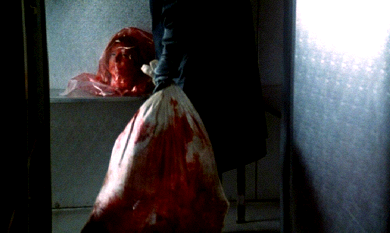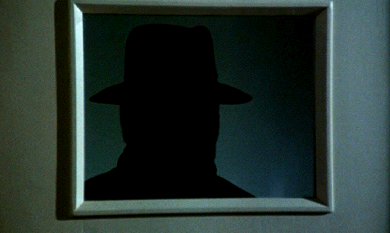Director: Juan Piquer Simón
Writers: Dick Randall, Roberto Loyola (as John Shadow), Juan Piquer Simón (uncredited)
Producers: Dick Randall, Stephen Minasian
Cast: Christopher George, Linda Day, Edmund Purdom, Ian Sera, Paul L. Smith, Frank Braña, Jack Taylor, Isabelle Luque, Cristina Cottrel, Leticia Marfil, Silvia Gambino, Carmen Aguado, Paco Alvez, Roxana Nieto, Hilda Fuchs, May Heatherly, Gérard Tichy, Alejandro Hernández, Alejandro de Enciso, Hugo Astar, Emilio Linder, Victor Iregua, Nicholas A. Burd, Mario De Barros, (and uncredited cast) Pilar Alcón (woman pictured in puzzle), Bruce Le, Juan Piquer Simón
In 1942 Boston, Massachusetts, a young boy (Alejandro Hernández) is putting together a jigsaw puzzle of a naked woman. When his mother (May Heatherly) surprises him in the act, she slaps and scolds him. As the mother is searching the boy’s bedroom for other “filth” to dispose of, the boy returns with an axe and murders her. Then the boy proceeds to saw his mother’s body into pieces. Forty years later on a Boston university campus, the now adult killer is conducting a fetishistic ritual of murder. He severs various pieces from his women victims to add to the grisly, human jigsaw puzzle he is assembling.
The Flashback Fanatic movie review
Like many real-life serial killers, the killer in Pieces has a sexual hang-up that is at the root of his murderous behavior. In this case, it rather neatly ties in with the killer’s MO. A nudie jigsaw puzzle creates the conflict leading to matricide and probably obsessive guilt that can only be assuaged by more killing to recreate a jigsaw corpse stand-in for the killer’s mother. This sort of psycho setup is one of my favorite aspects of slasher films. I am sure that psychologists and criminal profilers will find such a scenario to be much too simplistic. However, this is not much more deranged than the motivations and triggers for many real-life serial killers. If one wants to interpret more motivational depth into the killer of Pieces, it could also be assumed that the pornophile kid had some other issues before mom tried to dispose of his stash of smut.
There, I am glad I got that off my chest. I feel pretty damned proud about attributing more narrative and psychological integrity to Pieces than anyone else has in the past forty years. And you thought this flick was about nothing more than gore and naked chicks? Well, hang in there, I’m just getting warmed up...
The killer in Pieces has to be the stealthiest maniac ever. I can only surmise that dressing as The Shadow somehow allows him to cloud babes’ minds so they cannot see him. Of course, when they finally do notice him it is too damned late. The killer even possesses such sleight of hand prowess that while sharing an elevator with someone he can conceal his chainsaw behind his back.
You’ve got to admire police procedure in Pieces when it is this methodical and does not jump to conclusions. Lt. Bracken (Christopher George) asks for a professional opinion from the university anatomy teacher Professor Brown (Jack Taylor). When discovering the chopped apart remains of the poolside victim next to a bloody chainsaw, Bracken asks, “Could this have been done by a chainsaw?”
You’ve also got to hand it to Lt. Bracken for thinking outside the box. Apparently, cute coeds being butchered in rapid succession on a Boston campus does not allow Bracken to get the manpower he needs to secure the campus and catch the killer. So he is counting on mild-mannered student and chick magnet Kendall James (Ian Sera) to be his on-campus informant and to keep an eye on beautiful tennis star and undercover policewoman Mary Riggs (Linda Day). This kid is so popular that he can’t even be bothered to finish balling his latest horny honey before he takes off after Mary in the middle of the night just because he spots her wandering around the campus.
As all of the best exploitation films do, Pieces alerts us to an oft-ignored public safety concern. While the drug PCP was the trendy ’80s scapegoat for inducing irrational violent behavior, this film exposes the threat of bad chop suey causing spontaneous kung fu rages.
The outrageous extremes of Pieces have made it revered among trash film fans. Along with its madness, nudity, and gore, the film’s often out-of-left-field sense of humor and loopy characters distinguish it.
Topping the cast is the husband-wife acting team of Christopher George and Linda Day. As Police Lt. Bracken, George is that establishment hero that we expect to save the day. He surprises us with his choice of assistants in his investigations. Not only does he get a kid on campus to pitch in, he also has tennis star-turned-police officer Mary Riggs go to the university to operate undercover as a tennis coach. Sure, it’s unlikely but necessary. Without Linda Day as Mary Riggs on the job, we would not have that Oscar-worthy moment of histrionics when she discovers another campus corpse. I could quote her every time I encounter a plugged up men’s room toilet.
Paul L. Smith plays the hulking, chainsaw-cherishing university groundskeeper Willard. As if this does not make him look guilty enough, his face is afflicted with stink eye paralysis. It looks positively painful.
Edmund Purdom is the smooth and polished university dean. He manages to make everything he says sound reasonable while being completely ineffectual. He would go on to star in and begin directing the producers’ next fright flick Don’t Open till Christmas (1984).
Producers Dick Randall and Stephen Minasian set out to create something typical of the slasher genre and, accidentally or by impish intent, gave the horror fan something extra. Pieces is a lurid thriller flaunting its bad taste to achieve a campy intensity. It almost reaches the level of a parody without ever seeming quite so deliberate. Because we are not quite sure what the intent was with some of its goofier aspects, this film has become something unique. Randall and Minasian apparently captured lightning in a bottle with Pieces. Their next slasher Don’t Open till Christmas is lacking the crude, cockeyed fun found here and is merely unsatisfying.
Like many slasher films, Pieces has been labeled misogynistic. Of course, any film about a killer targeting women is dealing with misogynistic behavior. Does portraying such acts mean the filmmakers and their audience are misogynists? If so, then just what does this film’s ball-busting finale mean? It is perhaps the most outrageous WTF climax to any horror film. I think it is a dual-purpose bit of movie mischief that is tweaking the noses of the misogyny accusers at the same time it is flipping the bird to the male audience drawn to the sex-and-violence buzz of Pieces. If you can figure out a better reason for that ending, I’ll send you a case of lollipops.
































